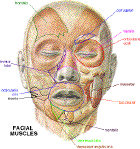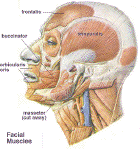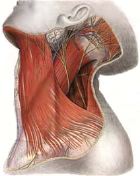Articulation: Facial Muscles
Facial Muscles:
 The Facial Muscles, and in particular those in the lips, help to shape the
sound and air stream into recognizable speech. Visible in this image (click
on it), these muscles move the face in response to our thoughts, feelings,
emotions and impulses. Actors work very carefully to learn how to isolate
each muscle. It is useful to learn to recognise the various muscles in order
to better isolate them, so that any extraneous movement is eliminated and
the muscles used are those desired. Also by recognising the muscles' shape,
it is easier to understand how the face is moved by these muscles.
The Facial Muscles, and in particular those in the lips, help to shape the
sound and air stream into recognizable speech. Visible in this image (click
on it), these muscles move the face in response to our thoughts, feelings,
emotions and impulses. Actors work very carefully to learn how to isolate
each muscle. It is useful to learn to recognise the various muscles in order
to better isolate them, so that any extraneous movement is eliminated and
the muscles used are those desired. Also by recognising the muscles' shape,
it is easier to understand how the face is moved by these muscles.
They are:
- frontalis: the forehead
- corrugator: the brow
- nasalis: the nose
- obicularis oculi: around the eye
- levator labii: raises the upper lip
- masseter: closes the jaw
- Obicularis oris: purses the lips
- risoris: draws the lips in a smile
- buccinator: pulls the lips wide and tight
- depressor labii: lowers the lower lips
- depressor anguli oris: lowers the bottom corner of the lips
- levator anguli oris (not shown): raises the upper corner of the lips
- pterigoid (not shown): pulls jaw back or shut
- mentalis: pulls chin down
 This
image features a clear side view of the facial muscles. You can see the temporalis
muscle, those on your temples under the hairline just above your ears, very
clearly. These are very active in chewing. Also visible is the large strap
of the buccinator muscle (latin for bugler), which pulls the side of the mouth
wide.
This
image features a clear side view of the facial muscles. You can see the temporalis
muscle, those on your temples under the hairline just above your ears, very
clearly. These are very active in chewing. Also visible is the large strap
of the buccinator muscle (latin for bugler), which pulls the side of the mouth
wide.
 The
platysma muscle covers the front of the neck, and is the muscle closest to
the surface. This image shows the angle at which one feels the platysma best,
by lifting the chin while turning the head to either side. This muscle often
tries to "help" as we speak, and learning to relax it can be very
difficult for some. It attaches to the jaw line and to the clavicle as it
smoothes over the neck.
The
platysma muscle covers the front of the neck, and is the muscle closest to
the surface. This image shows the angle at which one feels the platysma best,
by lifting the chin while turning the head to either side. This muscle often
tries to "help" as we speak, and learning to relax it can be very
difficult for some. It attaches to the jaw line and to the clavicle as it
smoothes over the neck.
For speech, the most important facial muscles are those that move the lips. All other muscles we want to relax as much as possible, especially the jaw muscles. In fact, some models are now having "botox", a form of botulism toxin, injected into some of their facial muscles, like the corrugator and frontalis, so that the muscles won't work and won't create wrinkles.
- Jaw
- Facial Muscles (on this page)
- Tongue
- intrinsic muscles
- extrinsic muscles
- Pharyngeal Constrictors
- Palates
- Hard Palate
- Soft Palate
Back to Articulation
Back to The Journey of the Voice
More on Articulation:
Master
Muscle List
Loyola University has
a great online learning area on anatomy. This link puts you in the Master
Muscle List by Region, where you should select "head and neck".
This will give you a huge long list of all the muscles in the head and neck
which you can use to learn more about these structures.

